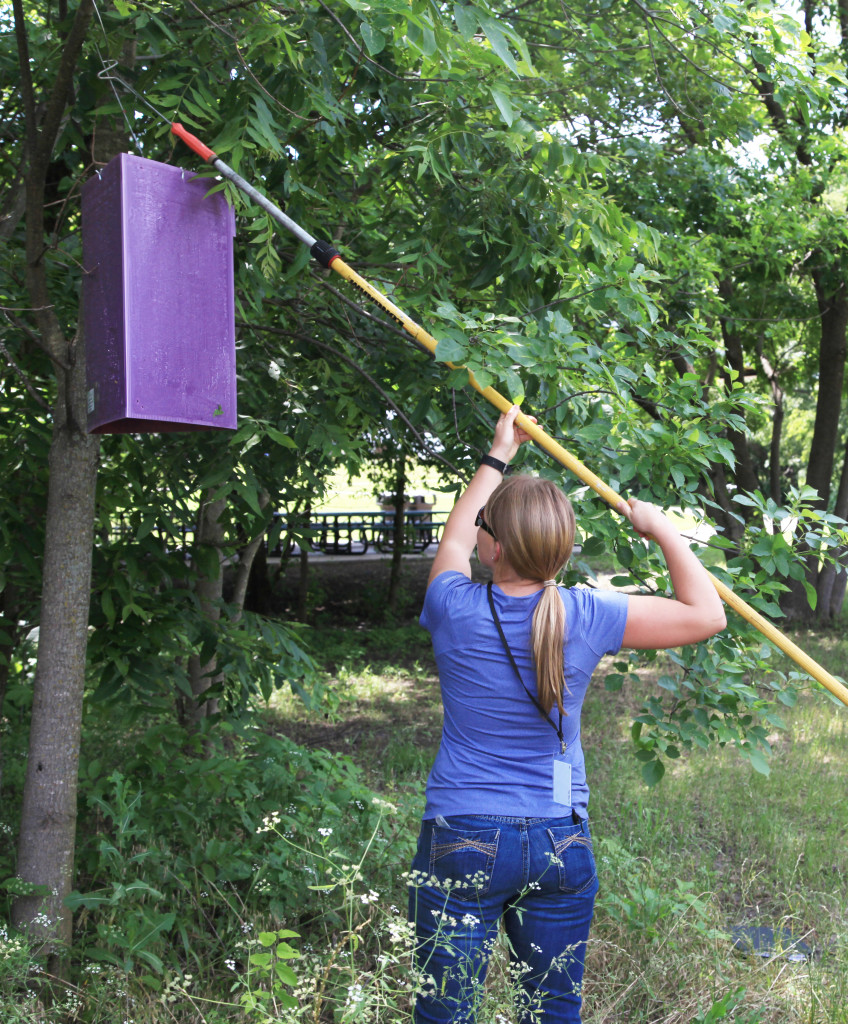
by Matt Lollar | May 24, 2016
From time to time I am reminded of how little I know. Honestly, I am reminded on a daily basis. A few weeks ago someone asked me about the purple things hanging from the trees. Luckily, the person gave me some good southern directions on where I could find one of these things hanging around in Marianna. So I drove out to the site to get a better look. What I saw hanging in the tree was a three-sided, purple triangle about two feet tall and a foot wide. It looked to me like someone got a box kite stuck in a tree. Upon further research, it was determined this box kite like thing was a monitoring trap for the emerald ash borer (EAB).
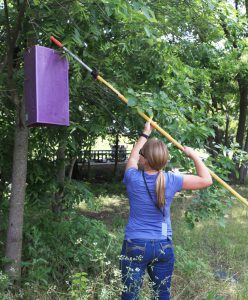
A woman hanging an emerald ash borer trap in a tree. Photo Credit: Texas A&M University
The emerald ash borer (EAB) is a destructive, exotic wood-boring beetle native to Asia. It was first discovered in North America in July 2002 and has made a home in Michigan, Ohio and Ontario, Canada. Millions of ash trees have been killed by the EAB in Michigan and invested ash tree nursery stock in other states indicates the potential for increased spread of the pest. EAB has made its way to the south and has been found in Louisiana and Arkansas.
Monitoring traps are not the only means of EAB detection. A proactive approach utilizing observant citizens can help keep an eye out for potential populations. You can use these tips to monitor your community for emerald ash borers:
Ash Tree Identification – Ash trees are identified by their (1) opposite branching pattern, (2) compound leaves with 5-9 leaflets, and (3) diamond shaped bark ridges on mature trees.
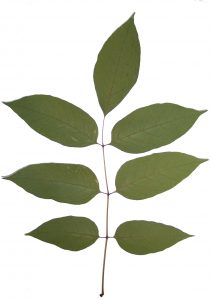
A compound leaf of an ash tree. Photo Credit: FDACS
Woodpecker Damage – Of course, not all woodpecker damage on ash trees is associated with EAB infestation, but woodpecker damage in the upper part of the tree can indicate their presence. The woodpecker damage is usually accompanied by vertical cracks in the bark.
Canopy Thinning – As the attack progresses, bark cracking continues and the canopy in the upper half of the tree begins to thin.
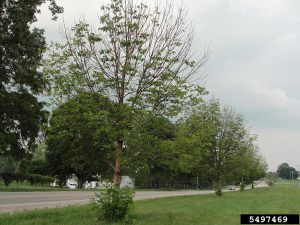
Michigan ash tree showing decline due to Emerald ash borer. Photo Credit: USDA
Tunnels and Holes – The emerald ash borer makes distinctive S-shaped tunnels that differ from damage from other borers.
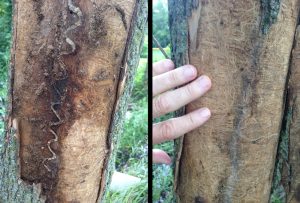
EAB Damage (left) VS Other Borer Damage (right). Photo Credit: Texas A&M University
This beetle hitchhikes on firewood and infests new areas at an alarming rate. Although the EAB has not yet been detected in Florida, transporting firewood from other states puts Florida ash trees at risk. Your help is needed to detect possible infestations so they can be quickly eradicated. The information available at the following links will help you identify the EAB, EAB host trees, and infestation symptoms.
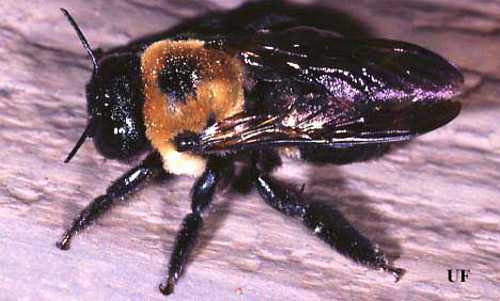
by Les Harrison | May 17, 2016
The hectic pace to contemporary life can justifiably be compared to the seemingly erratic behavior of insect pollinators. Darting from flower to flower with no apparently logical progression for choice of blooms, all the while emitting a mind numbing buzz.
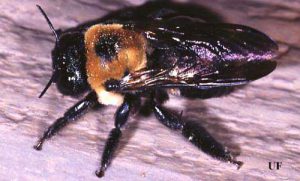
Adult large carpenter bee, Xylocopa sp. Photograph by Paul M. Choate, University of Florida.
This incessant and unending grind of bouncing from task to task has created an atmosphere of tedium and monotony which has become the anthem of many adults. As quick as one chore is complete, another replaces it. Russian composer Nokoli Rimsky-Korsakov wrote what might be considered today’s theme song at the dawn of the 20th century. “Flight of the Bumblebee” catches the frantic haste at which this insect functions, as well as its commonly encountered cousin the carpenter bee.
Bumblebees and carpenter bees are very similar in behavior, coloration and size. The easiest way to differentiate these insects is by their abdomen, the body segment furthest from the head. Bumblebees have an abdomen thickly covered in fine hairs. Carpenter bees lack the fine hairs and have a shiny abdomen.
Xyloxop micans Lepeletier, as the large carpenter bee is known scientifically, is one of more than 500 species worldwide. Almost all members of this genus build their nest by burrowing into dead wood. In the wilds of the panhandle this usually means deadfall timber of almost any sort. Unfortunately, in the areas which include human structures, the nesting sites include wooden timbers and siding.
Unlike European honeybees, the carpenter bees are labeled as solitary bees. There may, however, be several nests in close proximity to these active insects.
Nests are composed of a single parent that lays eggs in a segmented tubular nest. The nest openings are a nearly perfect 5/8 inch (16 mm) hole. Each nest has only a single opening, but multiple tunnels will branch off the main passage. These bees do not eat the wood removed to create the nest channels. Sometimes the holes are not visible to the observer, but the wood emits a buzzing or humming sound when these bees are nesting in hidden locations. In many cases small quantities of saw dust can be found on the ground under the hidden nest.
Heavy or repeated infestations can weaken structural timbers and severely damage siding. Decay and breakage will ultimately follow an untreated incursion.
While the damage caused by carpenter bees can be quite expensive, they may attract an even more destructive predator. Woodpeckers, especially the native pileated woodpecker, dine on carpenter bee larvae at every opportunity. These feathery insect assassins are attracted to the vibrations and hums of the bees hidden in wood. In some cases, the wood acts as a resonator and amplified the insect noise which assures an aerial assault. When discovery of the larvae is confirmed, the woodpeckers attack with a ferocity seldom seen in nature. The rapid-fire staccato of their hammering is loud and devastating.
Structural supports are compromised far beyond the damage done by the carpenter bees, and at a quicker rate. Siding is often shredded and left completely useless.
Commonly available insecticides can help control the carpenter bee population and reduce the prospects of woodpecker damage. Unfortunately, this only adds one more item to the long list of chores and task of contemporary adults.
For more information:
Featured Creatures: Large Carpenter Bees
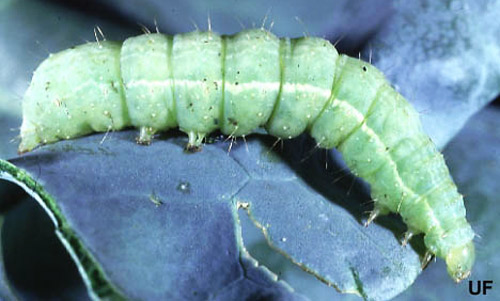
by Blake Thaxton | May 17, 2016
In the last few weeks, more garden pests have arrived! It is a fact of life in northwest Florida that we will have a few things in our garden including heat, moisture (humidity and rainfall), and BUGS! With a cooler spring the arrival of some of the troublesome pests in the garden seemed to be delayed a few weeks. It was nice while it lasted but the insect pests are here to stay until frost in the fall or winter (at least we hope for a frost this year).
There are thousands of insects that you can see in your garden. It’s wise to identify them before making a decision to spray an insecticide or remove them by another method. Insect samples can be taken to your local county extension office for identification.
In this article we will just discuss one of the top insect pests in the vegetable garden, caterpillars, and what you can do about them.

Mature larva of the cabbage looper. Photograph by John L. Capinera, University of Florida.
Beet armyworms, fall armyworms, hornworms, cabbage loopers, southern armyworms, tomato fruitworms, and other caterpillars love to feed on tomato foliage and fruit. They will show up eventually on tomato plants in the garden, if not this year then in the future. These larvae are immature moths and cause a lot of damage if left unchecked. The homeowner can control them effectively with Organic Materials Review Institute (OMRI) approved pesticides. A bacterial biological insecticide called Bacillus thuringiensis, also referred to as B.t., can be very effective in controlling these caterpillar pests. B.t. is a stomach toxin to these pests and will cause them to quit eating and starve to death. The key to using B.t. effectively is to routinely apply it before the caterpillars hatch from their eggs as the smaller caterpillars are easiest to control. Larger caterpillars are more difficult to control.
For more information related to using OMRI pesticides:
Organic Vegetable Gardening in Florida
Insecticides for Organic Commercial & Backyard Vegetable Production
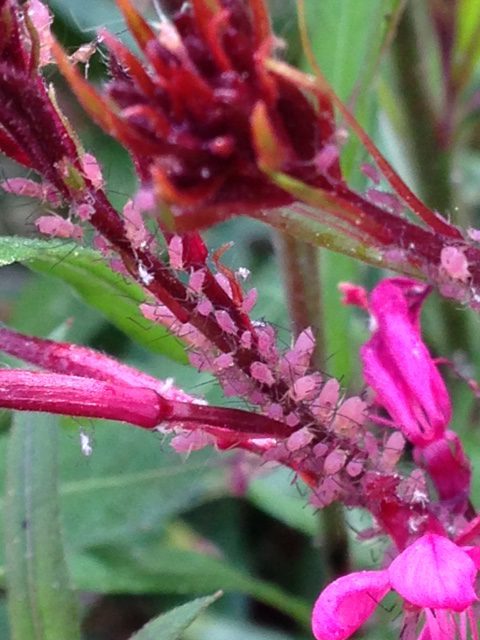
by Julie McConnell | May 5, 2016
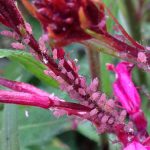
Aphids (Macrosiphum gaurae) feeding on gaura. Photo: Julie McConnell, UF/IFAS
Every day, if I get home before the sun goes down, I like to walk around my garden and see how things are growing. At this time of year there are always new surprises in the garden – plants leafing out after a winter break, new flower buds and blooms, and of course sometimes garden pests.
My daughter and I collected some flowers last weekend and after they sat on the table for a few minutes I noticed pink bugs crawling around on the gaura stems. On further inspection I realized the stem was covered in aphids which made me go out to look at the entire plant. I found a prolific population
of aphids on the gaura and also lady beetle larvae hunting and eating the aphids! Instead of mixing up a bottle of insecticidal soap I decided to let the lady beetles do their job and just monitor the situation.
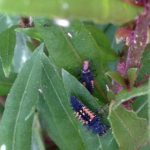
Multicolored Asian Lady Beetle Larvae feeding on aphids. Photo: Julie McConnell, UF/IFAS
Five days later I went to show my example of natural biological control to a visiting friend and we could not find a single aphid on my plant. This may not be the typical response, usually I see some level of both predator and prey but in this instance the lady beetle did a fantastic job of controlling the aphids.
So, did they eat every last one? Probably not, they likely ate many of them and the others left the plant because the predator pressure was too great. However, either scenario saved my plant from severe damage which was the overall goal.
by Beth Bolles | May 5, 2016
Believe it or not, there is a beneficial ant that is found in many landscapes. If you see an interesting mound shaped like a small volcano, you likely have the pyramid ants. These ants form small nests in sandy soils and the mound will have a small opening in the very center.
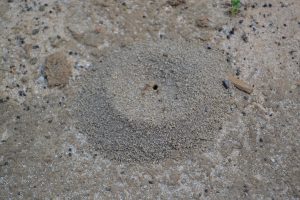
Pyramid ant mound, about 5 inches across. Photo by Beth Bolles
Pyramid ants are not aggressive and do not sting. They are fast moving over the ground building the mound and searching for food. Ants will collect honeydew from other insects and the beneficial part is that ants hunt live insects including winged fire ants. By allowing the pyramid ants to remain in parts of your landscape, you may reduce the numbers of fire ants that can establish in that area.
When you see the distinctive pyramid ant mounds, remember the beneficial role they play in keeping pest species in check. Keep any baits away from these areas to protect the pyramid ants.
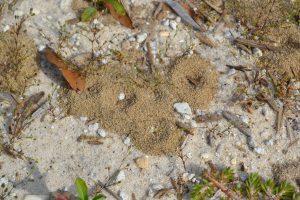
A group of small mounds. Photo by Beth Bolles
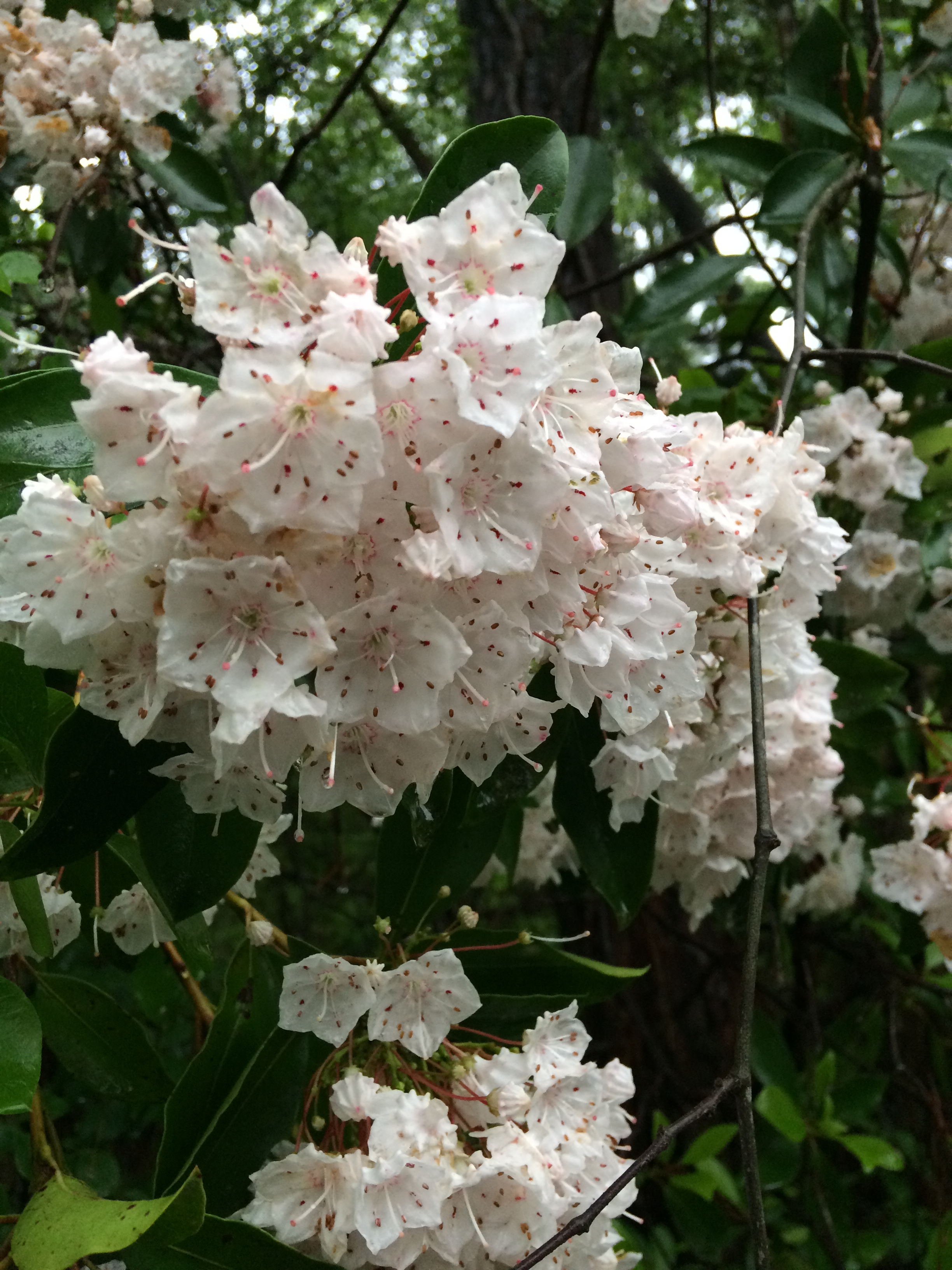
by Sheila Dunning | Apr 21, 2016
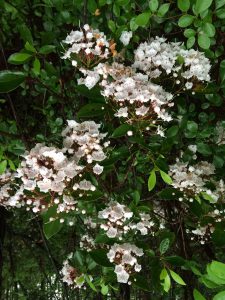
Mountain laurel. Photo credit: Sheila Dunning, UF/IFAS Extension.
If you are lucky enough to live on the southern Alabama edge of northwest Florida, you may want to see if you can find mountain laurel blooming now near the wooded creeks. Its native range stretches from southern Maine south to northern Florida, just dipping into our area. The plant is naturally found on rocky slopes and mountainous forest areas. Both are nearly impossible to find in Florida. However, it thrives in acidic soil, preferring a soil pH of 4.5 to 5.5 and oak-healthy forests. That is something we do have. The challenge is to find a cool slope near spring-fed water.
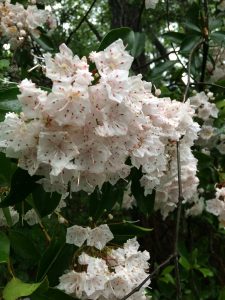
Mountain laurel blooms. Photo credit: Sheila Dunning, UF/IFAS Extension.
Mountain laurel (Kalmia latifolia) was first recorded in America in 1624, but it was named after Pehr Kalm, who had collected and submitted samples to Linnaeus in the 18th century. The wood of mountain laurel was popular for small household items. It is heavy and strong with a close, straight grain. However, as it grow larger it becomes brittle. Native Americans used the leaves as an analgesic. But, all parts of the plant are toxic to horses, goats, cattle, deer, monkeys and humans. In fact, food products made from it, including honey, can produce neurotoxic and gastrointestinal symptoms in people consuming more than a modest amount. Luckily, the honey is usually so bitter that most will avoid eating it.
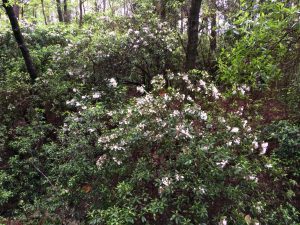
Mountain laurel in its native habitat. Photo credit: Sheila Dunning, UF/IFAS Extension.
One of the most unusual characteristics of mountain laurel is its unique method of dispersing pollen. As the flower grows, the filaments of its stamens are bent, creating tension. When an insect lands on the flower, the tension is released, catapulting the pollen forcefully onto the insect. Scientific experiments on the flower have demonstrated it ability to fling the pollen over 1/2 inch. I guess if you don’t taste that good, you have to find a way to force the bees to take pollen with them.
The mountain laurel in these pictures is from Poverty Creek, a small creek near our office in Crestview. This is their best bloom in 10 years. Maybe you can find some too.
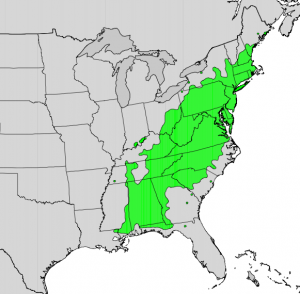
Native range of mountain laurel.



















